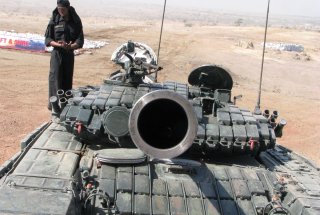Could India's T-72 and T-90 Tanks Beat China in a War?
New Delhi thinks so. But is that really accurate?
Despite the high altitudes and extreme temperatures, the Depsang plains are flat and quite suitable for tanks. It is the critical point where Indian tanks could threaten Aksai Chain at the eastern portion of the larger Kashmir region. It has also been the subject of the dispute between India and China since the 1962 border war was fought between the two nuclear powers.
The Eastern Ladakh Valley regularly witnesses harsh winters when the temperature normally dips to minus 35 degrees Celsius at night coupled with strong winds. It would seem an inhospitable region to fight a war, but this is where one could begin as tensions remain high between New Delhi and Beijing.
In recent weeks, India has begun to deploy more than fifty thousand troops armed with heavy weapons, as well as large numbers of its Soviet/Russian-designed T-72 and T-90 tanks along with the BMP-2 Infantry Combat Vehicle—and all have been equipped with special fuels to operate at temperatures up to minus 40 degrees Celsius.
“We have not seen the deployment of the Chinese light tanks opposite our area so far,” an Indian Army senior officer posted in the eastern Ladakh told India Today TV. “But even if they deploy it and it takes part in a duel against us, it will be of no match to our strong and sturdy T-90 and T-72 tanks.”
India’s T-72 and T-90s
India operates some 1,900 variants the Soviet-designed T-72 main battle tank (MBT), which entered production in 1971, including the T-72M and T-72M1. India has operated the T-72, powered by 780 horsepower diesel engines, since the early 1980s and has subsequently been produced domestically under license in India. These are based on the export versions of the T-72 and were originally armed with a 125 millimeter D-81T smoothbore tank gun, but many have been retrofitted with the French 155-millimeter F-1 turret or the British 155-millimeter Vickers T6 turret.
Some 310 T-90S MBTs entered service with India in 2001. It was chosen as it was a direct development of the T-72 that India already was producing with 60 percent commonality, which simplified both the training and maintenance. The T-90 was actually selected over the domestically developed Arjun MBT to counter the Pakistan military’s Ukrainian-made T-80 tanks.
India’s T-90M Bhishma—named after a character in Mahabharata epic—sports French-built thermal sights, and Russian Kontakt-5 explosive reactive armor (ERA). Its turret also has domestically developed composite armor, a mixture of ceramic and other laminates, which may offer better protection than the stock T-90S, the Russian export model. Unlike the Arjun, which is ideal for the hot conditions of India's plains, the T-90MS variant was designed specifically for the cold, harsh conditions of Ladakh, Sikkim, and Arunachal Pradesh in far north and eastern regions.
The Chinese T-15
Countering the Indian Army’s T-72s and T-90s may be the Chinese People’s Liberation Army’s (PLA’s) T-15 light tank. During exercises in the region in June, Beijing deployed its new light tank, which had only made its public debut at the National Day military parade last October.
The lightweight tank, which is also reported to be highly mobile on the flat plateaus, had first been deployed near the Line of Actual Control—the de facto border between India and China along the Himalayas—last January.
The Type 15 lightweight tank has a thinner armor and smaller 105-millimeter main gun, so it lacks the hitting power of its Indian counterparts. But the light weight could make it far more suitable for operations in the mountainous conditions near the LAC. The Norinco-produced tank at thirty-three-tons is about half the weight of a typical main battle tank, which is necessary given the thinner air and rugged terrain. Heavier armored vehicles typically struggle due to the lack of oxygen to support the engine.
Additionally, that 105-millimeter gun can fire armor-piercing shells as well as guided missiles. It would still need to get in and out of a fight in a hurry, and may have speed on its side—but the openness of the Depsang plains may not give the light tank the cover it needs. If war does come to the region it isn't clear at this point which side truly has an advantage.
Peter Suciu is a Michigan-based writer who has contributed to more than four dozen magazines, newspapers and websites. He is the author of several books on military headgear including A Gallery of Military Headdress, which is available on Amazon.com.
Image: Reuters

